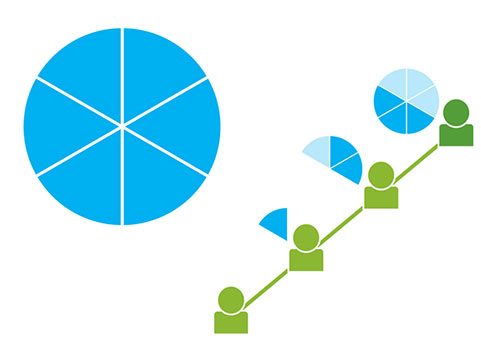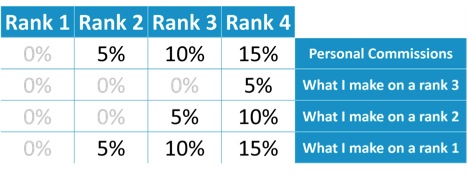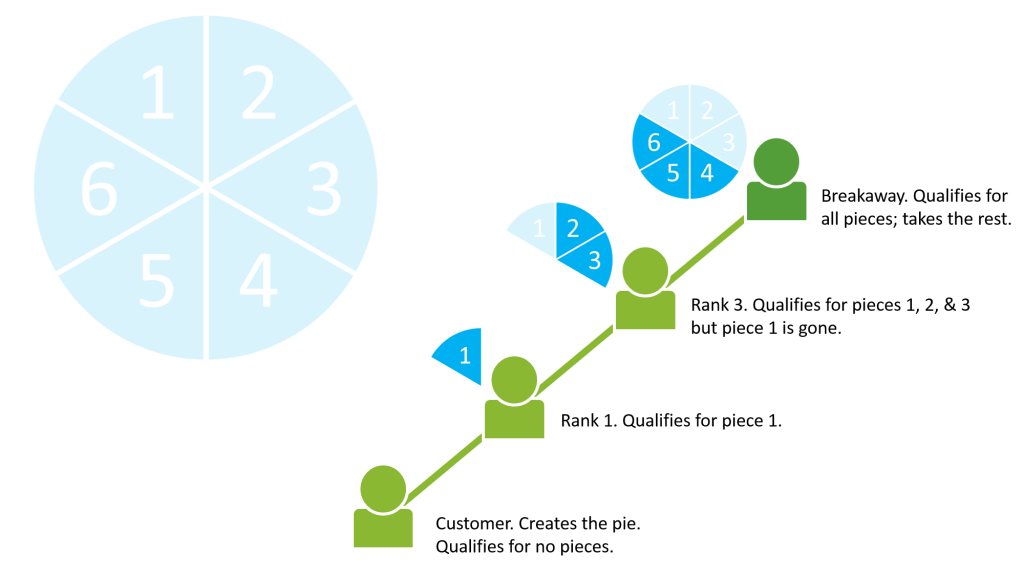SHARE
What’s a differential commission?

Differential commissions focus earnings based on a specific distributor behavior. A level commission stabilizes earnings and spreads the wealth. A differential commissions maximizes commissions to those who are performing the activity the company chooses to reward.
How differential commissions work
In a differential commission, each rank qualifies for a different percentage of the commissionable volume. The distributor receives that percentage minus the percentage taken by qualifying distributors below them in the tree. So, if you qualify for 10% of the total differential commission, you’ll get 10% if no one beneath you qualifies at all, 5% if someone below you qualifies for 5%, and 0% if someone below you qualifies for 10% or more.

In the chart above we can see an example of ranks and what they qualify for in a differential. In this example we can see that a rank 4 distributor gets 5% if the commission comes to them by way of a rank 3 distributor.
The concept of a differential commission can be difficult to understand. Let’s think about the total commission—meaning all of the money that commission will pay on one sale—as a pie. Let’s say that the pie is cut into six pieces. It’s traveling upline, and as it goes up, each distributor it passes qualifies (based on rank) to take certain pieces of the pie, if they’re still there. So rank 1 distributors can take piece 1. Rank 2 distributors can take pieces 1 and 2. Rank 3 distributors can take pieces 1–3, and so on.
The pie arrives at the nearest rank 1 distributor, and that distributor takes the first piece. The pie then arrives at the nearest rank 2 distributor and that distributor takes the second piece. However, if there is no rank 1 distributor between the customer and the rank 2 distributor, that distributor gets both the first and second piece.
Differential example


• The customer generates the volume.
• The first upline distributor is at rank 1. She qualifies for piece 1 and the whole pie is still there—so she gets 1 piece.
• The second upline distributor is at rank 3. He qualifies for pieces 1, 2, & 3, but piece 1 has already been taken—so he gets 2 pieces.
• The third upline distributor is at rank 6. She qualifies for the whole pie, but half of it has already been taken—so she gets 3 pieces.
If the next distributor above our rank 6 was also rank 6, he wouldn’t get any of the differential commission even though he qualifies for it, because there is none left to pay.
Pros
Pays the sales people
Differential commissions are a good way to make sure that salespeople get paid enough to be motivated to work with consumers and new distributors.
Targets specific activity
It’s self-adjusting, in that if distributors become more involved and start building the business appropriately, the commissions automatically start to migrate to them. This allows the cream to rise to the top. The distributors are in charge of their own destinies. They know in advance what’s required. They always get the reward if they perform the predefined tasks.
Resistant to stacking
Differential commissions are not susceptible to stacking. If an organization stacks, it doesn’t take payout away from the upline. This commission is harder to manipulate Distributors must build appropriately in order to earn commissions.
Cons
One person can take all the “pie”
Level commissions are where everyone gets an equal slice of each pie. In differential commissions all of the pie can be eaten before it gets to me. If I have someone in my downline that is equal to or at a higher rank than I am, they will qualify for more pieces of the pie. I will never get any.
Volatile payout
You cannot build an entire compensation plan around differential commissions. Companies need to add other commission families to build a stable earnings base.
Complex
It’s the most difficult to understand of all the families. It’s been in use for many years by some of the most successful companies. However, few can calculate a differential commission with accuracy.
Examples of level commissions
Stairstep differential
For many years, the most popular member of this commission family has been the stairstep. The differential pays the salespeople for the time they must spend to take care of their customers. Stairstep bonuses typically pay between 0-25%.
When distributors join a company they are on the lowest “step.” As they meet the requirements to climb the steps, they earn increasing percentages on their personal and group volume. For example, at rank 4, a distributor might earn 15% on their own sales, 5% on the sales of any rank 3, 10% on any rank 2, and 15% on any rank 1.
Stepped infinity differential
The second major member of the differential family is the stepped infinity bonus. In this structure, it’s in theory possible for distributors to be paid on their entire organization (in other words, “to infinity”). The key difference between stepped infinity and stairstep commissions is the amount of downline volume required to qualify and the percentage paid for each.
It is important to note, that someone in their downline who is eligible for the same percentage of commission will “block” them from that point down. This commission is more complex, but it rewards distributors who build wider.
Summary
Differential commissions have proven to be valuable components for a long-term stable and successful network marketing business. This family falls in and out of favor but has weathered the test of time.
Want help designing a differential commission for your company’s compensation plan? Reach out to us at MLM Compensation Consulting. We offer data-driven compensation plan design and analysis.
If you need help with your compensation plan design or analytics, contact www.mlm-cc.com or 801-416-3648 or sales@mlm.com.
This article is an adapted excerpt from Mark Rawlins’ book From Commission Plan to Compensation Strategy. Give it a read if you want even more information about commissions and how they come together in compensation plans.
you may also like
Essential Software Customizations for MLM, Direct Selling, and Affiliate E-commerce
Navigating the changing landscape of e-commerce, particularly within MLM, direct selling, and affiliate marketing channels, requires more…
How to Ensure Your Compensation Plan and Software Work Well Together
Peanut butter and jelly. Milk and cookies. Batman and Robin. Everybody knows these famous pairings work well…
Podcast 53: Advantages Using an Interim VP of Sales for Direct Selling Companies
Today we welcome a returning guest of this podcast: Jeff Jordan. Jeff has also written articles for…
compensation consulting for mlm companies
We offer data-driven compensation plan design & analysis
MLM.com Newsletter
Get our e-mail newsletter, with MLM.com articles & online exclusives, delivered to your inbox each week.



